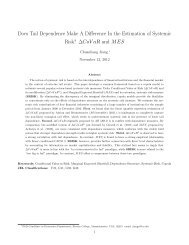Chapter 18. Introduction to Four Dimensions Linear algebra in four ...
Chapter 18. Introduction to Four Dimensions Linear algebra in four ...
Chapter 18. Introduction to Four Dimensions Linear algebra in four ...
Create successful ePaper yourself
Turn your PDF publications into a flip-book with our unique Google optimized e-Paper software.
The determ<strong>in</strong>ant is def<strong>in</strong>ed recursively as before. If we let Aij be the 3 × 3 matrix<br />
obta<strong>in</strong>ed from A by delet<strong>in</strong>g row i and column j then for any row i we have<br />
det(A) =<br />
and for any column j we have<br />
det(A) =<br />
4�<br />
j=1<br />
4�<br />
i=1<br />
(−1) i+j aij det(Aij)<br />
(−1) i+j aij det(Aij).<br />
Properties 1-6 of chapter 14 cont<strong>in</strong>ue <strong>to</strong> hold. No matter how you expand det(A),<br />
you get the same sum of 24 terms<br />
det(A) = �<br />
sgn(σ)a1σ(1)a2σ(2)a3σ(3)a4σ(4)<br />
σ<br />
(3)<br />
= a11a22a33a44 − a12a21a33a44 + a12a21a34a43 ± · · · ,<br />
where the sum is over all 4! = 24 permutations σ of the numbers 1, 2, 3, 4 and<br />
sgn(σ) = ±1 is itself the determ<strong>in</strong>ant<br />
sgn(σ) = det(Aσ)<br />
of the permutation matrix Aσ given by Aei = eσ(i).<br />
Our only purpose for writ<strong>in</strong>g out a few terms of the expansion (3) is <strong>to</strong> make<br />
it clear that det(A) is a polynomial expression <strong>in</strong> the entries of A. This clarifies<br />
our earlier assertion that “usually” two planes (or <strong>four</strong> hyperplanes) <strong>in</strong>tersect <strong>in</strong> a<br />
s<strong>in</strong>gle po<strong>in</strong>t. Indeed, we have seen that this <strong>in</strong>tersection is the kernel of the matrix<br />
A whose rows are the hyperplanes be<strong>in</strong>g <strong>in</strong>tersected, and ker A = 0 exactly when<br />
the polynomial det is nonzero at A, which is what usually happens, for a random<br />
matrix A.<br />
When ker A is larger than 0, it has a nonzero dimension which can be computed<br />
us<strong>in</strong>g determ<strong>in</strong>ants of submatrices of A. To expla<strong>in</strong> this we first need some<br />
def<strong>in</strong>itions. Fix 1 ≤ k ≤ 4, and choose a pair of k-element subsets<br />
I = {i1, . . . , ik}, J = {j1, . . . , jk}<br />
of {1, 2, 3, 4}. Let aIJ be the determ<strong>in</strong>ant of the k × k matrix whose entry <strong>in</strong> row<br />
p column q is aipjq. We call aIJ a k-m<strong>in</strong>or of A. For example, a 1-m<strong>in</strong>or is just<br />
an entry aij <strong>in</strong> A and det(A) itself is the unique 4-m<strong>in</strong>or of A.<br />
4

















